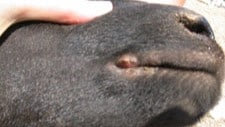Key points
- Orf virus infection occurs worldwide in sheep and goats and sometimes other animals with hooves.
- Often called Sore Mouth Disease, the infection causes sores on animals' mouths and other areas.
- People can get the disease when they touch infected animals.

Overview
Sheep and goats may get sores on their lower legs and teats, especially when female animals are nursing infected young. When infected with orf virus:
- Nursing animals with sores on their udders may abandon their young
- Young animals may not be able to nurse
- Young animals may need bottle or tube feeding
- Older animals with sores in their mouths may also need help feeding
Animals almost always recover completely within a month. Some breeds, especially Boer goats, may be more likely to get sore mouth infection. These breeds may also have more severe illnesses if they get infected.
Animals can get infected multiple times during their lives. Repeat infections usually occur after at least a year and are generally less severe.
How it spreads
Fluid from the sores of an infected animal contains the orf virus. The virus can spread to other animals through cuts or scrapes in the skin.
The teats of female animals may become infected through nursing lambs or kids. Any direct contact between animals — muzzle to muzzle or skin to skin — can spread the virus between animals.
Orf virus is particularly hardy in scabs or fluid from the sores. The virus can remain alive on equipment and in the environment for months, possibly years. Some areas often contaminated include pastures, animal bedding, feed and troughs, and buildings housing animals. It can be hard to completely get rid of orf virus from areas where an infected animal is present.
Prevention
There are commercially available preparations of live orf virus marketed for use as vaccines. Vaccination practices vary depending on breed and geographic location.
Producers considering using an orf vaccine product in their flock should first consult a veterinarian to discuss benefits or negatives.
It can be difficult to prevent infection since orf virus survives in the environment, in soil and water. You can lessen the chance of your animals getting sick by:
- Removing thistle and harsh brush from pastures.
- Disinfecting feed troughs used by more than one animal.
- Disinfecting buildings where animal husbandry occurs.
- Washing/disinfecting hands between touching sick and healthy animals.
- Isolating new animals until sore mouth is ruled out.
- Opening your animal's mouth at public events.
